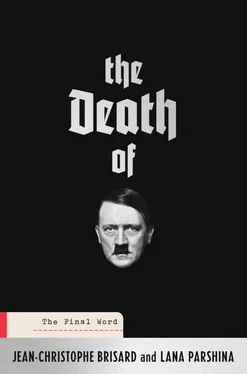By the time he found himself in charge of the U-530, an up-to-date submarine with a very long range, in January 1945, Wermuth had never been a commander. The vessel under his command was quite daunting. It was over seventy-six metres long, and could hold a crew of up to fifty-six. With its torpedo and mine launchers, as well as its deck gun, it was a formidable weapon. But the young commander would not really have time to put it to the test.
Sent on a mission off the American coast in April 1945, the U-530 fired nine torpedoes on Allied ships just south of Long Island, near Hudson Bay. These attacks were a complete failure. None of the bombs hit their targets. Wermuth learned of the German capitulation and received the order from his staff to surrender. He refused and decided to flee to Argentina. At the time, that country was a military dictatorship. Even though, under pressure from the United States, the Argentinian rulers had declared war on Germany on 27 March 1945, they continued to feel a certain admiration for the Nazi model. On 10 July 1945, after a two-month voyage, the U-530 arrived 400 kilometres south of Buenos Aires, at the city of Mar del Plata. Wermuth was taken prisoner along with his vessel and its crew. The news spread very quickly. And with it, the suspicion of the presence of Adolf Hitler and his wife Eva Braun on board the submarine. As well as being drawn towards fascism, Argentina had a German community clustered together in Bavarian-style villages in Patagonia. Perfect ingredients for the scenario of Hitler taking refuge in South America.
As soon as he had disembarked, Wermuth was interrogated by both the Argentinian and US navies. The German officer was suspected of berthing in other small towns a few hours before his surrender on 10 July. Had he taken advantage of those stops to unload passengers or documents? On 14 July 1945, a memo was sent to Washington by the American naval attaché based in Buenos Aires. He reported the arrival of a submarine that had unloaded two unidentified passengers.
The Argentinian press also picked up the adventure of the U-530 and published article after article about Hitler still being alive. One of those reports, published in the magazine Critica on 18 July, claimed that the German dictator had found refuge at the South Pole, in an area where the temperature was bearable. The Argentinian Foreign Minister, César Ameghino, was obliged to intervene officially, to put a stop to these rumours. On the day of the publication of the article, he issued a formal denial. Hitler had not been set down on the Argentinian coast by a German submarine.
Still, the FBI investigated the South American trail. Not least because the American secret service had also received some surprising reports. In particular, one about Robert Dillon, a mediocre Hollywood actor. On 14 August 1945, he contacted the FBI to tell them he had met an Argentinian who had been involved in taking Hitler into his country. The story of the submarine again! Dillon went further in his details. The Führer had disembarked with two women, a doctor, and about fifty men. They had hidden in the hills of the Southern Andes. Hitler was suffering from asthma and ulcers. He had also shaved off his moustache. After being checked by the American special services, Dillon’s “scoop” melted away.
Over the years, reports of this kind piled up on the desks of the FBI. They concern Hitler, but also the presence of other Nazis in Brazil, Chile, Bolivia and, of course, Argentina. Not all of these rumours were wildly far-fetched. There really were systems of escape routes for Nazi criminals. One of the best-known of these was the Odessa network. Over the years, it would allow officials from the Third Reich to escape from Europe. It is also true that Argentina offered asylum to numerous Nazi torturers. Among the most notorious of these, Josef Mengele (a doctor in the Auschwitz concentration camp, guilty of barbarous medical experiments on the inmates there), Adolf Eichmann (an active organiser of the “Final Solution’), and Klaus Barbie (head of the Gestapo in the French city of Lyon). But not a trace of Adolf Hitler.
Ten years after the Nazi capitulation, in July 1955, the German legal system decided to close the file on Hitler once and for all. The court in Berchtesgaden, the little town in Bavaria with 7,000 inhabitants, was appointed to lead the investigation. A purely symbolic choice: the German dictator had liked to withdraw to the town for some peace and quiet. He had built his personal residence there, the Berghof. So it was this provincial court that would rule on the Führer’s legal status: dead or alive. The timing was no coincidence. It coincided with the return of Nazi prisoners held by the Soviets. These included key witnesses of the last hours in the Führerbunker, the air-raid shelter where the dictator ended his days. Close to Hitler, they had been captured by the Red Army and immediately imprisoned secretly in the Soviet Union. Their statements had never been made public or transmitted to the Western allies. And certainly not to the German courts. But in 1955 Moscow agreed to free the last Nazi war criminals who were still rotting away in its jails. A political gesture that would have a cost for West Germany; in exchange, the country committed itself to establishing diplomatic and economic relations with the USSR. As soon as they returned, the German courts interrogated these senior dignitaries of the Third Reich. Thanks to their testimonies, it was possible to conclude that Adolf Hitler and his wife, Eva Braun, had taken their own lives on 30 April 1945. On 25 October 1956, Hitler and his wife were officially declared dead by the court in Berchtesgaden. From that moment, the death of the master of the Third Reich could be officially written down and published in history books around the world. The FBI also called off its investigations. For a decade, the American secret services had been carrying out investigations all over the world. With a certain relief Washington accepted the evidence of Hitler’s suicide in his bunker. But the essential factor was still missing: the body. At the time, there was still no physical proof of his death. Until the skull appeared.
Early 2000. The USSR had ceased to exist eight years previously, since its dissolution on 25 December 1991, to be precise. A new Russia tried to rebuild itself amid the ruins of a Communist regime that had been dying for years. Its status as a superpower had disappeared at the same time as the hammer and sickle on its flag. The liberal shock treatment applied by Boris Yeltsin turned the already precarious social and economic balance of the country into a train-ride to hell. In the eyes of the world, the red peril with its enormous nuclear arsenal had disappeared for good. The Russians felt humiliated. But in the year 2000, hope revived in the Kremlin. A new president had taken control of the reins. Admittedly he was young and a little bit shy, but he brought a welcome gravity and temperance to Russia after the Yeltsin years. His name was Vladimir Putin, and he was only forty-seven. This lieutenant colonel in the KGB had only one idea in mind: to restore his country’s glory, and put it back at the centre of the global political chessboard. By way of introduction, he reminded the world that Russia was a great military power. And that it was Russia that had won the war against Hitler.
On 27 April 2000, the eve of the fifty-fifth anniversary of the victory over Nazi Germany, Moscow opened a major exhibition of its secret archives. Its title left no doubt about the Russian President’s intentions: “Agony of the Third Reich–the Punishment.” This was unheard-of. In all, a hundred and thirty-five previously unpublished documents were revealed to the public; documents that the historians of the Second World War had dreamed of consulting for half a century. Soviet secret service reports classified as “top secret,” photographs, objects… everything that lifted the veil on the last minutes of Hitler in his bunker. The diary of Martin Bormann, the Führer’s secretary and confidant, was also on show: “Saturday 28 April: our Reich Chancellery is now nothing but a pile of ruins. The world is hanging on by a thread. […] Sunday 29: fire storm over Berlin. Hitler and Eva Braun got married.” Photographs of the Goebbels children, the correspondence of Nazi officials such as the architect of the regime and its arms minister, Albert Speer: “Hitler is decomposing before our eyes. He has turned into a bundle of nerves and completely ceased to control himself.” But the key exhibit was elsewhere, in a special room. An article from Le Monde describes the scene: “In the middle of a room hung with red velvet, a charred fragment of skull, punctured by a bullet-hole, has pride of place in a glass case.” [1] Le Monde , 2 May 2000, Agathe Duparc.
Читать дальше












